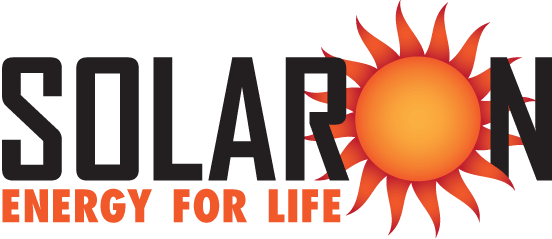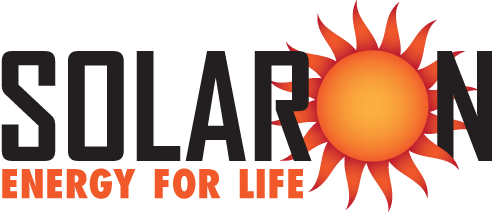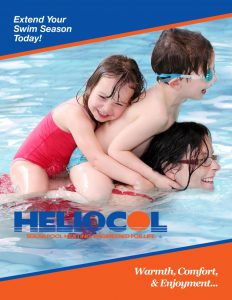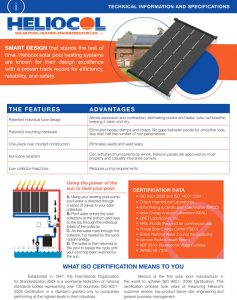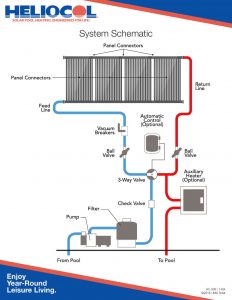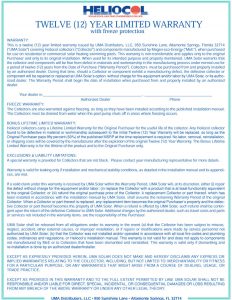What to Expect of Your Pool Heating System
Solar heating for swimming pools is a proven technology. It will provide years of low-cost heating for your pool, but you should be aware of its advantages and limitations.
The biggest advantage of solar heating is of course its cost effectiveness. The energy that the panels receive is really free in the truest sense of the word. On a sunny day, the surface of the panel receives a continuous stream of energy from the sun. Most systems use the filter pump to send the water to the panels. In most cases good results can be obtained by running the pump about 6 hours per day. (There are exceptions: please see the section “Maximizing Your System”.) This is not an extra electrical expense, since most pools need to be filtered about that long during warm weather anyway. In that scenario, there is no additional expense for the heating. Of course, the original purchase price of the system is an expense, but since well-constructed systems last 15-20 years, the annual heating expense is quite small. Ongoing maintenance expenses are negligible, since the panels, the most expensive apart of your system, are covered by a long warranty and require no maintenance. Another advantage is that solar energy is a “clean” energy. Unlike fossil fuels, it is non-polluting, and thus good for the environment.
You should be aware of some inherent limitations of solar heating. A solar system is not like a gas heater. The heat per hour supplied by most large swimming pool heaters (measured in “BTUs”) far exceeds the output of a solar system. Because of this, the solar system will take a few days, even a week or so, to reach its maximum temperature output. The maximum depends on a number of factors:
Angle of sun to collector
This is often not understood by consumers. The closer that angle is to 90 degrees the more intense the heat. An easy way to understand this is to think about using a magnifying glass to burn a hole in a piece of paper. If you turn it so that the light is diffused over a larger area of the paper it will not be as hot. Solar panels work best when 1 square foot of sunlight falls on 1 square foot of panels, not diffused over a larger area. This is why, in the northern hemisphere, we try to put collectors on a south-facing roof. The sun for most of the swim season is somewhat south of straight overhead (except around the solstice — June 21), so a panel angled that way will have more days close to that 90-degree angle. Systems facing other compass headings can work if sized properly. Early and later in the year, the sun is quite low in the south and panel performance is decreased.
Daytime Temperature
When the ambient air temperature around the panel is cool, the panel will not perform quite as well. Why not? Because some of the solar heat being gathered is being transferred to the air around the panel, rather than into the cool water running through it. If the air is cooler than the pool itself, the pool too, is giving some of its heat back to the air around it. Interestingly, this is why a west facing system is much better than an equivalent east facing system. Yes, they both receive the same angle of sunlight, but at different times of the day. The west system receives its best sunlight in the afternoon when the ambient air temperature is much warmer. And in very hot weather, both the pool surface as well as the collectors can transfer some ambient heat to the water in addition to the solar energy being obtained.
Nighttime Temperature
Although no water is running through the panels at night (unless you use the system to cool your water), the pool will always give back some of its heat again overnight. Again, in the fall and early spring this will be greater, so the next day’s starting temperature is lower. And unfortunately, the warmer the pool, the more it gives back overnight due to the greater contrast in temperatures. And this is why there is a maximum obtainable temperature. The pool will reach a balance point where the heat obtained during the day will match the loss overnight. During the swim season, this maximum can be quite high, usually higher that the low to mid eighty degree water most swimmers prefer.
Wind
When the air is cooler than the panels, wind will affect performance, similar to how humans experience wind chill. The pool surface also is cooled by wind. Brisk winds, even when the air temperature is warm, will cool the pool because of evaporative cooling.
Shade
Obviously, the solar panels cannot be in full shade all day long. Some shading may be OK, as long as there is a five-hour or greater period where direct sun is on the majority of the panel surface. Shaded pools will naturally be cooler than pools in full shade. For these pools, solar is really needed, but maximum temperature expectations may be lower.
So, all of these factors considered, what should you expect?
A well-designed and properly sized system should make your pool warmer by an appreciable amount. A broad rule of thumb would be about a 6-12 degree increase over what your pool would be without solar heating, from about late April to early October. Typically, in Northern California, late fall and winter produce such cold overnight temperatures that solar heating cannot, by itself, maintain comfortable heating. In years with an “Indian Summer” and a pool cover, we have had customers swim even in November, but this is the exception rather than the rule. Please bear in mind that every pool is different, and time of year and weather affect performance. We often get calls comparing a solar pool to another pool, with or without solar. Some pools are shallower, less shaded, or more protected from the wind. All we can do is make your pool warmer, by an amount that makes your investment worthwhile. Is an increase of 6-12 degrees worthwhile? The difference between a 74-degree swim and an 80-degree swim is huge! If owners of non-solar pools were to count up the days when they wish their pool was warmer, either to get into the water, or to stay in longer, there would be a lot of days.
One other note: Please make sure you are using an accurate thermometer. We have had multiple instances of inexpensive thermometers that are reading as much as 10 degrees off. Some of these have the degree scale glued-on next to the mercury column, and when the scale gets loose it can slide up or down, giving a completely erroneous reading.
